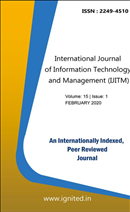Analysis the Investment Alternatives Asset Class of Indian Real Estate Market
Main Article Content
Authors
Abstract
The present research aimed to study the real estate market in India brimming with enormousgrowth yet lacking academic presence. The research involved both primary as well as secondary data.The study's target audience consisted of investors in India who use real estate as a vehicle. The survey'ssampling unit consisted of individuals who purchased an apartment or built floors with the aim of rentingthem out in order to benefit from their real estate investment. Participants in the survey had to haveinvestments made after 2008. Utilizing multistage (3 stage) stratified sampling, primary data wasgathered. HPI data from Q4 2008–09 to Q2 2017–2018 was used to get secondary information about homeprices. A sample of 747 respondents has been contacted for the study. The sample has been trim downto 543 after accounting for missing data. Utilizing frequency tables, frequency charts, crosstabs, thedemographic profile of the 543 respondents has been described.
Downloads
Download data is not yet available.
Article Details
Section
Articles
References
- Bardhan, A., Edelstein, R. H. and Tsang, D. 2006. Global Financial Integration and Real Estate Returns. Available at SSRN: http://ssrn.com/abstract=905313.
- Bardhan, A.D., Edelstein, R.H., and Leung, C., 2004. A Note on Globalization and Urban Residential Rents. Journal of Urban Economics, 56:505-513 pp.
- Benefield, J D, Cain C L, and Johnson K H, (2011), "On the Relationship Between Property Price, Time-on-Market, and Photo Depictions in a Multiple Listing Service”, Journal of Real Estate Finance and Economics, Vol:43, PP:401-422
- Benefield, J D, Rutherford R C, and Allen M T, (2012), " The Effects of Estate Sales of Residential Real Estate on Price and Marketing Time”, Journal of Real Estate Finance and Economics, Vol.: 45(4), PP: 965-981
- Benjamin, D. John (2003), “The Environment and Performance of Real Estate”, Journal of Real Estate Literature, Vol. No. 11, Page 279 to 324.
- Benjamin, J D, Chinloy P T, Jud G D, and Winkler D T, (2005), "Technology and Real Estate Brokerage Firm Financial Performance”, Journal of Real Estate Research, Vol.: 27, PP: 409-426
- Bollen, K. A., & Stine, R. (1990). Direct and indirect effects: Classical and bootstrap estimates of variability. Sociological methodology, 115-140.
- Bond, S. A., Karolyi, G. A., & Sanders, A. B. (2003). International real estate returns: a multifactor, multicountry approach. Real Estate Economics, 31(3), 481-500.
- Chan, K. F., Treepongkaruna, S., Brooks, R., & Gray, S. (2011). Asset market linkages: Evidence from financial, commodity and real estate assets. Journal of Banking & Finance, 35(6), 1415-1426.
- Chandrasekhar, C. (2011). The housing market and housing finance under liberalization in India. Global Housing Markets: Crises, Policies, and Institutions, 343-356.
- Chandrasekhar, G. S. (2011). Indicators of Real Estate Cycle - Implication for India. ICREI, ISB , pp. 20.
- Colwell P F & Yuvas A, (1995), "A Comparison of Real Estate Marketing Systems: Theory & Evidence", Journal of Real Estate Research, Vol:5, PP:583-599
- Darrat, A. F., and Glascock, J. L., 1993, On the Real Estate Market Efficiency, Journal of Real Estate Finance and Economics 7: 55-72.
- Hoesli, M., & Lizieri, C. (2007). Real estate in the investment portfolio.
- Ibbotson, G., & Siegel, B., (1984). „Real Estate Returns: A Comparison with Other Investments, ‟Journal of Real Estate Economics, vol. 12(3), pp. 219-242
- Zhu, J.M., Sim, L.L., and Zhang, X.Q., 2006. Global Real Estate Investments and Local Cultural Capital in the Making of Shanghai's New Office Locations. Habitat International, 30:462-481 pp.

